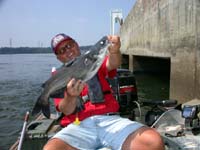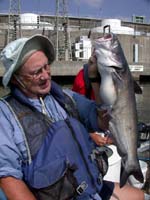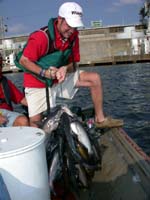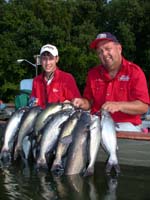
|
Features
|
|
|
|
Books
|
|
|
|
Fun & Games
|
|
|
|
Contact Us
|
|
|
John's Journal... Entry 254, Day 5
HOW TO FISH SUMMERTIME CATFISH
What Cats Like
 Editor's
Note: "Don't want no bream or crappie, Only one fish that makes me happy:
Catfish, catfish." (Taken from the musical "Pumpboys & Dinettes") Plenty
of anglers across the U.S. share the sentiments of this song from "Pumpboys
and Dinettes." They love the fun of matching baits to the seasons of the
year and the places where they fish to catch cats, and they enjoy the
delicious white meat of catfish. Although many anglers believe that throwing
a stink bait out on the bottom of any river in the summer will catch catfish,
to consistently take more cats on every outing, you need to know where
the fish most likely will occur, what they will eat in these spots, and
what conditions will cause them to feed most actively. You can check with
biologists, local anglers and area sporting-goods stores to learn what
catfish prefer to eat in your part of the state at each time of the year.
Several factors affect when and what catfish eat. The temperature of the
water governs how actively catfish feed because the enzyme action in a
catfish's stomach doubles with each 8-degree increase in water temperature.
The hotter the weather becomes, the more catfish feed. Since most catfish
prefer a dark habitat, they eat mostly at night during the hottest, sunniest
weather. My friend, Phil King of Corinth, Mississippi, an expert angler
and guide for catfish who primarily fishes Pickwick Lake on the Alabama/Mississippi/Tennessee
border, says that during the summer you'll most likely catch big catfish
an hour or two after daylight with the secondary peak time from 8:30 a.m.
until 10:30 a.m.
Editor's
Note: "Don't want no bream or crappie, Only one fish that makes me happy:
Catfish, catfish." (Taken from the musical "Pumpboys & Dinettes") Plenty
of anglers across the U.S. share the sentiments of this song from "Pumpboys
and Dinettes." They love the fun of matching baits to the seasons of the
year and the places where they fish to catch cats, and they enjoy the
delicious white meat of catfish. Although many anglers believe that throwing
a stink bait out on the bottom of any river in the summer will catch catfish,
to consistently take more cats on every outing, you need to know where
the fish most likely will occur, what they will eat in these spots, and
what conditions will cause them to feed most actively. You can check with
biologists, local anglers and area sporting-goods stores to learn what
catfish prefer to eat in your part of the state at each time of the year.
Several factors affect when and what catfish eat. The temperature of the
water governs how actively catfish feed because the enzyme action in a
catfish's stomach doubles with each 8-degree increase in water temperature.
The hotter the weather becomes, the more catfish feed. Since most catfish
prefer a dark habitat, they eat mostly at night during the hottest, sunniest
weather. My friend, Phil King of Corinth, Mississippi, an expert angler
and guide for catfish who primarily fishes Pickwick Lake on the Alabama/Mississippi/Tennessee
border, says that during the summer you'll most likely catch big catfish
an hour or two after daylight with the secondary peak time from 8:30 a.m.
until 10:30 a.m.
 All
North American species of catfish, which you may know by the nicknames
of Mr. Whiskers, no-scales, creek cats, river cats and shovelhead catfish,
have long feelers or barbels (whiskers) on their faces. These barbels
enable catfish to find food because a catfish tastes with its feelers
as well as its entire body. A catfish has more than 100,000 food sensors
located all over its body with the largest number in its whiskers. A catfish
discovers food by fanning the bottom with its barbels and honing in on
vibrations as well as by following food scents. Some catfish, particularly
the channel catfish, feed by sight too. Catfish like to eat almost anything,
including various fish like gizzard and threadfin shad, suckers, mullet,
freshwater mussels, hellgrammites, worms, leeches, frogs and decaying
matter, since they often feed close to the bottom. To catch catfish, determine
what baits naturally occur in an area, and fish them first. Because catfish
eat such a wide variety of foods, you can catch them using many different
baits and tactics, including bush hooks, yo-yos, snag hooks, limb lines,
slat traps, basket traps, trammels and gillnets where allowed by law as
well as conventional catfish tactics such as rods and reels, trotlines
and jugs.
All
North American species of catfish, which you may know by the nicknames
of Mr. Whiskers, no-scales, creek cats, river cats and shovelhead catfish,
have long feelers or barbels (whiskers) on their faces. These barbels
enable catfish to find food because a catfish tastes with its feelers
as well as its entire body. A catfish has more than 100,000 food sensors
located all over its body with the largest number in its whiskers. A catfish
discovers food by fanning the bottom with its barbels and honing in on
vibrations as well as by following food scents. Some catfish, particularly
the channel catfish, feed by sight too. Catfish like to eat almost anything,
including various fish like gizzard and threadfin shad, suckers, mullet,
freshwater mussels, hellgrammites, worms, leeches, frogs and decaying
matter, since they often feed close to the bottom. To catch catfish, determine
what baits naturally occur in an area, and fish them first. Because catfish
eat such a wide variety of foods, you can catch them using many different
baits and tactics, including bush hooks, yo-yos, snag hooks, limb lines,
slat traps, basket traps, trammels and gillnets where allowed by law as
well as conventional catfish tactics such as rods and reels, trotlines
and jugs.
 White
catfish, which today fish-for-pay ponds stock heavily because they can
live with largemouth bass, prefer gizzard and threadfin shad to eat. You
can take white cats easiest on live bait with canepoles and/or spinning
tackle. Although often anglers catch blue cats by jugging since they prefer
cut fish bait or meat like chicken or beef livers or innards, flathead
catfish won't have anything to do with decaying matter. You may take a
flathead on a trotline, a handline or a jug using baits like bream, small
catfish and crappie in states when you can angle with live fish or crayfish,
gizzard shad and cut fish. Flatheads like to lie quietly in shallow water
against big boulders or under submerged logs with their large mouths open
to catch frightened fish. Channel catfish will hit both cut-fish baits
and chicken innards on set-lines as well as shrimp and artificial lures
like deep-running spoons, jigs and plugs on casting tackle. However, the
bullhead catfish prefers a natural bait like suckers, crayfish and mollusks
or lures such as wet flies, tiny jigs and spinners fished on canepoles
or light-spinning tackle. Other catfish food preferences may include hot
dogs, frogs, salamanders, freshwater clams, catalpa worms, fish entrails,
various kinds of soap - Ivory, Palmolive, Camay and Octagon - as well
as cheese balls, soybean meal cakes and flavored sponge baits.
White
catfish, which today fish-for-pay ponds stock heavily because they can
live with largemouth bass, prefer gizzard and threadfin shad to eat. You
can take white cats easiest on live bait with canepoles and/or spinning
tackle. Although often anglers catch blue cats by jugging since they prefer
cut fish bait or meat like chicken or beef livers or innards, flathead
catfish won't have anything to do with decaying matter. You may take a
flathead on a trotline, a handline or a jug using baits like bream, small
catfish and crappie in states when you can angle with live fish or crayfish,
gizzard shad and cut fish. Flatheads like to lie quietly in shallow water
against big boulders or under submerged logs with their large mouths open
to catch frightened fish. Channel catfish will hit both cut-fish baits
and chicken innards on set-lines as well as shrimp and artificial lures
like deep-running spoons, jigs and plugs on casting tackle. However, the
bullhead catfish prefers a natural bait like suckers, crayfish and mollusks
or lures such as wet flies, tiny jigs and spinners fished on canepoles
or light-spinning tackle. Other catfish food preferences may include hot
dogs, frogs, salamanders, freshwater clams, catalpa worms, fish entrails,
various kinds of soap - Ivory, Palmolive, Camay and Octagon - as well
as cheese balls, soybean meal cakes and flavored sponge baits.
 To
learn more about Phil King and his fishing and guide service, you can
call him at (662) 286-8644, e-mail him at pking@tsixroads.com,
or go to www.h2ow.com/catfish/.
For more information about catching catfish, order John E. Phillips' book,
"The Masters' Secrets of Catfishing," at www.nighthawkpublications.com/fishing/masterscatfish.htm.
To learn more about fishing below the dam at Pickwick,
contact the Hardin County Convention and Visitor’s Bureau at info@tourhardincounty.org,
call 731-925-8181 or 800-552-3866, or visit www.tourhardincounty.org.
Pickwick Landing State Park offers fishing, boating, hiking, camping,
swimming and golf. Lodging includes the lakeside inn with over 100 rooms,
cabins that sleep eight and a campground that contains 48 sites with grill
and electric/water hookup at each site. A restaurant at the park offers
delicious southern cuisine. Call 731-689-3135 or 800-250-8615 to learn
more.
To
learn more about Phil King and his fishing and guide service, you can
call him at (662) 286-8644, e-mail him at pking@tsixroads.com,
or go to www.h2ow.com/catfish/.
For more information about catching catfish, order John E. Phillips' book,
"The Masters' Secrets of Catfishing," at www.nighthawkpublications.com/fishing/masterscatfish.htm.
To learn more about fishing below the dam at Pickwick,
contact the Hardin County Convention and Visitor’s Bureau at info@tourhardincounty.org,
call 731-925-8181 or 800-552-3866, or visit www.tourhardincounty.org.
Pickwick Landing State Park offers fishing, boating, hiking, camping,
swimming and golf. Lodging includes the lakeside inn with over 100 rooms,
cabins that sleep eight and a campground that contains 48 sites with grill
and electric/water hookup at each site. A restaurant at the park offers
delicious southern cuisine. Call 731-689-3135 or 800-250-8615 to learn
more.
Check back each day this week for more about HOW TO FISH SUMMERTIME CATFISH ...
Day 1 - Small Streams And
Little Rivers
Day 2 - Large River Cats
Day 3 - Below Dams and in Main Lakes
Day 4 - Main Lakes and at Various Depths
Day 5 - What Cats Like